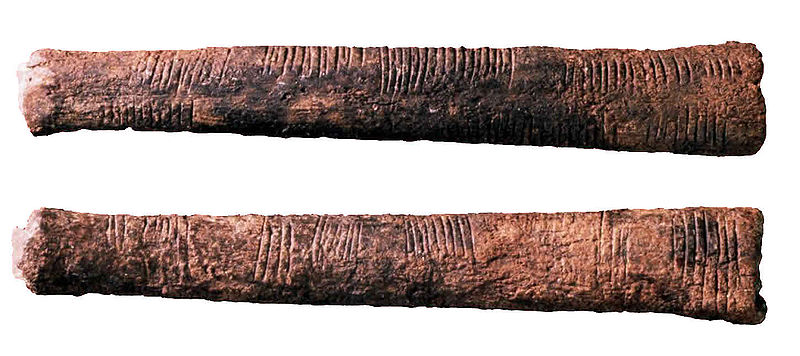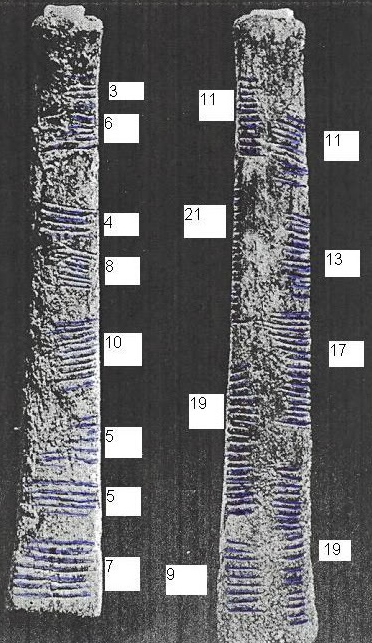The Ishango Bone:
Craddle of Ancient Mathematics
Today, I would like to talk about the Ishango bone, or rather the first evidence of a calculator in the world. Named after the place where it was found in theDemocratic Republic of Congo (DRC), the Ishango bone is what is called a bone tool or the craddle of mathematics. Dating as far back as 22000 years ago, in the Upper Paleolitic era, the Ishango bone is a dark brown bone which happens to be the fibula of a baboon, with a sharp piece of quartz affixed to one end for engraving. It is the oldest attestation of the practice of arithmetic in human history.
The Belgian geologist Jean de Heinzelin de Braucourt uncovered the bone buried in layers of volcanic ashes on the shores of Lake Edward in the Ishango region in DRC, near the border with Uganda. The Ishango bones are actually two (2) bones of baboon, 10 to 14 cm long, with several incisions on each faces. The smallest of the two bones was the first to be exposed at the Royal Belgian Institute of Natural Sciences in Brussels; it carries several incisions organized in groups of three columns.

The left column can be divided in 4 groups, with each group possessing 19, 17, 13, and 11 notches. The sum of these being 60. Those are the 4 successive prime numbers between 10 and 20. This constitutes a quad of prime numbers.
The central column is divided in groups of 8. By an approximate count, one can find (in the parenthesis, is the maximum number): 7 (8), 5 (7), 5 (9), 10, 8 (14), 4 (6), 6, 3. The minimal sum is 48, while the maximal sum is 63.
The right column is divided into 4 groups, where each group has 9, 19, 21, and 11 notches. The sum of these 4 numbers is 60.
The second bone has not been well-studied. However, we know that it is composed of 6 groups of 20, 6, 18, 6, 20, and 8 notches.
The first bone has been subject to a lot of interpretation. At first, it was thought to be just a tally stick with a series of tally marks, but scientists have demonstrated that the groupings of notches on the bone are indicative of a mathematical understanding which goes beyond simple counting. In fact, many believe that the notches follow a mathematical succession. The notches have been interpreted as a prehistoric calculator, or a lunar calendar, or aprehistoric barcode.
Jean de Heinzellin was the first to consider the bone as a vestige of interest in the history of mathematics. For instance, he noted that the numbers in the left column were compatible with a numeration system based on 10, since he saw that: 21 = 20 + 1,19 = 20 – 1, 11 = 10 +1, and 9 = 10 -1. These numbers are also prime numbers between 10 and 20: 11, 13, 17, 19.
Some other scientists such as the Belgian physical engineer proposed that the bones were probably a slide rule. While Alexander Marshack has indicated that the bones could refer to the oldest lunar calendar on earth. Claudia Zaslavsky thinks that the author of the Ishango bone must have been a woman following the lunar phases to calculate her menstrual cycle. However, the second bone completely rules out the lunar calendar theory, and favors more the numeration system.
All said, it is amazing to realize that there were mathematicians 20,000 years ago on the African continent. It is so great to realize that my ancestors, on the shores of Lake Edouard, were actually brilliant scientists playing with prime numbers. Whether it was a woman calculating her menstrual cycle, or some brilliant tribe astronomer, it feels so good to know that the paleo-mathematicians of Ishango already knew prime numbers. They were a great civilization long before the pharaohs of Egypt. Thus, in reality, the Ishango bone is the oldest table of prime numbers in the world. To read more, check outMathematicians of the African Diaspora,, the Prime Glossary, and Wolfram Mathworld.
>via: http://afrolegends.com/2013/08/29/the-ishango-bone-craddle-of-mathematics/



